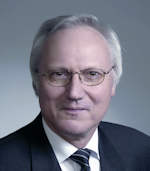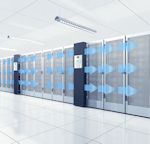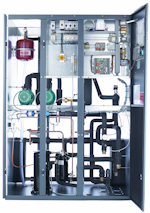STULZ: keep it cool – Kurt Plötner
The challenges facing the world's data centres are daunting, particularly in the financial services industry. Banks are dependent on constant server availability, with any downtime proving potentially disastrous. But with energy prices rising and new generation capacity growing at a slow rate, maintaining this rate of connectivity is proving increasingly difficult and expensive.
As well as the energy used to power the equipment itself, the second-most capital-intensive process in a data centre is air-conditioning. Server racks generate ever-greater computing power in an ever-decreasing surface area - power that is almost entirely converted into heat. This has a negative impact on the performance of the computers, which are at their best in temperatures of around 24°C. It also means that IT hardware is now responsible for the emission of more CO2 than even global air traffic.
This is due in no small part to waste and inefficiency. Independent surveys generally put energy used by cooling systems at 25-50% of total data centre consumption. In effect, this means that some centres dedicate less than half their total output to actually powering computers. According to Kurt Plötner, director of global product sales and marketing at precision air-conditioning provider STULZ, these levels of waste can be significantly reduced if banks look to devise more environment-specific data centres.
"Potentially, there is a large variety of solutions available to fit the customer's exact situation," he explains. "Data centre cooling for a bank in Hamburg will be different to that in Cairo because of the big variations in ambient temperature. Special control systems and high-tech fan technology can create an extremely efficient cooling set-up, and we can help the client come up with the most suitable design and best practice."
All-round energy efficiency
In order to build the most efficient system, air-conditioning should be a consideration from the earliest stage of planning. As well as contemplating the particulars of technology and ambient conditions, banks need to decide what balance to strike between capital expenditure and operational cost. Approaches to this have changed notably in recent years, driven primarily by the effect that rising energy prices could have on long-term operational expenditure (opex).
"Five years ago, nobody was talking about opex," says Plötner. "Banks wanted the lowest purchase price for equipment and operating costs were of no interest. That has changed completely.
"We now ask clients, 'How long a payback time would you accept if we offer you energy-efficient equipment? And they will answer that two to three years is fine. Our customers expect a total cost of ownership calculation where different systems are compared and it is easy to see which is preferable."
This change has not been brought about solely by necessity. A clear ethical shift has been observed towards more sustainable operations, with banks actually beginning to take pride in the green credentials of their infrastructure. Plötner advocates a strong relationship between the customer, equipment provider and rack manufacturer to devise the most efficient solutions.
There are many resources available: air-conditioning systems with recirculating air or liquid cooling, and hybrid set-ups with intelligent electronic processors help to eliminate waste. The STULZ Test Centre can help simulate load conditions during the planning phase and, prior to installation, ready assembled air-conditioning systems undergo extensive trials in a climatic chamber.
"We don't just move boxes," Plötner says. "We advise customers on how to get the utmost efficiency out of high-density racks or data centres. You have to consider the height of the raised floor, whether it is cold aisle or hot aisle control and what level of density you expect. You can't just give a catalogue to a client and ask them to choose a model."
Customised maintenance
The involvement of the equipment provider stretches as far as maintenance. STULZ tailors its servicing policies to the specific needs of the client. Its inspectors are available 24 hours a day. As well as taking care of conventional repairs, they can carry out an extensive thermographic analysis of a data centre.
If the measured values deviate from a selection of set points, the air-conditioning system is recalibrated; if the cooling capacity is no longer sufficient, STULZ can identify the causes and makes suggestions for a system upgrade.
Plötner strongly advocates bringing in the equipment manufacturer to carry out, or even just oversee, installation and maintenance. In cases where this doesn't happen, it often proves detrimental to the customer. Data centres are often constructed and maintained by general contractors, which, in turn, use air-conditioning installers that are uncertified by the equipment manufacturer. Each new heat source changes the thermal load distribution of a data centre, and each new piece of hardware can force the flows of hot and cold air out of balance.
"The data centre has a lot of moving parts and mistakes are often made that can prove disastrous in a mission-critical environment," he says. "There are many common issues, including wrong pipe size and pipe installation methods, and incorrect procedures in refilling refrigerant.
"If you are not paying the manufacturer to do the installation as well, the least you should do is bring in a commissioned engineer from the factory. Also, you should never go with the lowest bidder. Look at their qualifications and track record when it comes to installing precision air conditioning in mission-critical environments."
Temperature control
Over the next few years, Plötner believes technology will completely transform temperature control in the data centre. Although he chooses not to divulge many details, the use of direct cooling through water, refrigerant or fresh air will become increasingly prominent. While not all of these ideas are yet suitable for the financial services sector, nothing can be ruled out.
"The security and safety requirements of a bank are naturally very important," he says. "In some industries, losing a few servers due to bad environmental control is OK. In banking, you cannot be offline for more than 40 minutes a year. But we will show our clients the advantages and disadvantages of these technologies if they want to see them.
"Data centre cooling is our core business. We are not a kind of department store that offers many things to many clients."
The savings to be made from adopting a carefully tailored, high-tech cooling system are clear. In fact, STULZ precision air-conditioning systems have been shown to cut the electricity consumption of a data centre by up to 40%. With capital outlays rising across the financial services sector, this could provide a piece of welcome relief.



